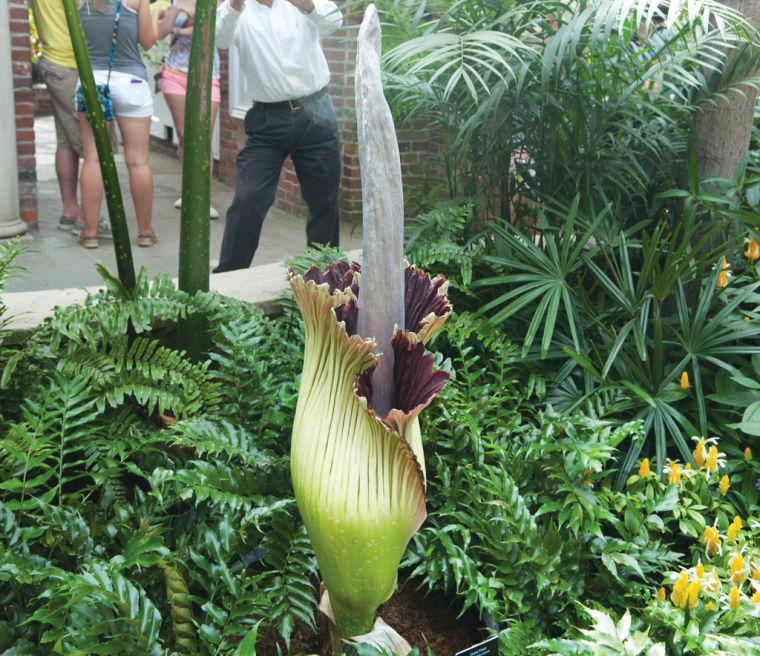‘Corpse flower’ draws cult crowd to Phipps Conservatory
August 27, 2013
Last Wednesday night, a massive horde of spectators filled Phipps Conservatory. The staff of the conservatory did their best to control this mob as it shambled slowly, yet relentlessly, in pursuit of the inviting scent of rotting flesh. The night of the blooming corpse flower was in full swing.
Unfortunately, or perhaps fortunately for this crowd, the corpse flower’s trademark stench had all but dissipated since the flower first bloomed during the late afternoon on Tuesday. Romero, Phipps Conservatory’s blooming Amorphophallus Titanum — more commonly known as a corpse flower because of its distinctive scent — was still quite a spectacle to behold. The massive flower was easily taller than many in the room.
Romero’s rarity alone made it a sight worth seeing for many. A native of Sumatra, Indonesia, the corpse flower is one of the rarest and largest flowers on the planet, not to mention one of the strangest. Rather than utilizing a saccharine scent to draw in pollinators like many other flowers do, the corpse flower takes a more morbid route, relying on beetles and flies for pollination that are attracted to the scent of rotting flesh the plant releases. In short, it’s a plant that fits comfortably into the annals of “Ripley’s Believe It or Not”.
According to exhibit coordinator Jordyn Melino, Romero was acquired by Phipps Conservatory in 2010. Because of the genetic diversity of various corpse flowers — the species can bloom anywhere from every 6 to 10 years — it was a mystery when exactly the towering flower would finally rise up and become the smelly plant it could be.
After three years of waiting, the plant finally began to put up a bud about three weeks ago, forcing the conservatory to quickly begin planning what exactly to do to celebrate the momentous occasion. For those organizing the exhibit, the choice in theme was glaringly obvious. With the city’s long-standing tradition of producing zombie films such as “Night of the Living Dead,” directed by George Romero, no name but Romero would fit.
“Pittsburgh’s the zombie capital,” Melino remarked.
Once the big day had finally arrived, the crowds poured in to get a whiff, and the conservatory was packed with everyone from families on a Tuesday-night gathering to zombie lovers on an impromptu date night. According to conservatory docent Jeffrey Lunz, the interpretations of the scent were as diverse as the clientele. When he asked visitors for the smell they most associated with Romero, the answers ranged.
“I got dead fish. I got Roquefort cheese, Limburger cheese,” Lunz said, adding that several med students compared it to “[clostridium difficile] diarrhea,” and perhaps most troublingly, that “one lady said she works in a prison and it smells just like that.”
Wednesday night’s celebration of the events took the zombie theme and carried it a step further, with two screenings of Romero’s seminal zombie flick, “Night of the Living Dead,” zombie-themed cocktails and a question-and-answer period with one of the members of the film’s original crew, Gary Streiner.
Streiner was quick to note that, though the film never actually used the word zombie, the conservatory’s decision to build the exhibit around the zombie theme was “very marketing smart” and spoke to the legacy Romero had built for himself in the city.
Sadly, the celebrations couldn’t last long. After about 48 hours, the corpse flower began to collapse in on itself and wither away, leaving only memories of a stench and a rare moment when it seemed perfectly natural to discuss zombies and rare flowers in the same breath.
For those who unfortunately missed the event, though, there may a sequel. Behind Romero, there stand a series of green stalks nearly as tall as the flower itself. These are the stalks of Phipps Conservatory’s other corpse flower, which represent the promise that one night, a corpse flower would rise again.








